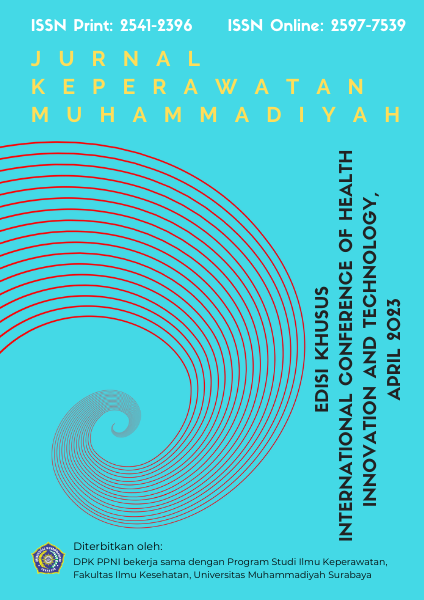STROKE RISK FACTOR ANALYSIS USING STROKE RISK SCORECARDAT RSUD DR. HARJONO S. PONOROGO
DOI:
https://doi.org/10.30651/jkm.v0i0.17870Keywords:
Factors, Stroke Risk ScorecardAbstract
Objective: Stroke is a condition that occurs when the blood supplay to a part of the brain is suddenly interrupted, because some brain cells die due to disruption of blood flow due to blockage or rupture of brain blood vessels. Death of brain tissue can lead to loss of fungtions controlled by that tissue. Stroke is the main cause of fungtional disorders, where 20% of patients who survive still require treatment at a health institution after 3 months and 15-30% of sufferers experience permanent disability. The introduction of risk factors for stroke is very important, beacause many patients have more than one risk factor and are sometomes ignored, so that the incidence of stroke cannot be avoided. Practical strategies in dealing with the burden of stroke should focus on prevention and treatment based on risk factors. This study is an observational analytic study with a cross-sectional design to determine the relationship between risk factors and the level of risk of stroke patients hospitalized at RSUD dr. Harjono S Ponorogo. This type of research is non-experimental research. This study was conducted in the stroke patient inpatient room.
Methods:. The research design used (crosssectional), this sampling technique used consecutive sampling and tabulated data. The sample is 60 respondents. The research instrument uses medical records to view the respondents basic data and medical diagnosis, and the stroke risk scorecard to obtain the results of the assessment of stroke risk factors and the risk level of stroke patients.
Results: The results of the study from 60 medical records of stroke patients, risk factors that were proven to have a significant relationship with the level of stroke risk were blood pressure, smoking history, cholesterol levels, history of diabetes. Meanwhile, based on the stroke risk scorecard, the risk level for stroke is mostly high risk.
Conclusion: The risk factors that were shown to have a significant relationship with the level of stroke risk based on the results of the distribution table were blood pressure, smoking history, cholesterol levels, history of diabetes. Meanwhile, based on the Stroke Risk Scorecard, the level of stroke risk in stroke patients at Dr. Harjono S Ponorogo Hospital is mostly high risk.References
American Heart Association/American Stroke Association. (2018). Acute Ischemic Stroke: A Guideline For Healthcare Professionals From The Stroke.
Badan Litbangkes Kemenkes RI. (2013). Laporan Hasil Riset Kesehatan Dasar Indonesia (Riskesdas).
Essebag, V., Baldessin, F., Reynolds, M. R., McClennen, S., Shah, J., Kwaku, K. F., ... & Josephson, M. E. (2005). Non-inducibility post-pulmonary vein isolation achieving exit block predicts freedom from atrial fibrillation. European heart journal, 26(23), 2550-2555
Go, A. S., Mozaffarian, D., Roger, V. L., Benjamin, E. J., Berry, J. D., Blaha, M. J., … Turner, M. B. (2014). Heart Disease and Stroke Statistics—2014 Update. Circulation, 129(3). https://doi.org/10.1161/01.CIR.0000441139.02102.80
Gofir, Abdul. (2009). Manajemen Stroke Evidence Based Medicine. Yogyakarta: Pustaka Cendekia Press.
Murthi, B. (2003). Prinsip dan Metode Riset Epidemiology. Jakarta: Gajah Mada University Press.
Pinzon, R., & Asanti, L. (2010). Awas stroke! pengertian, gejala, tindakan, perawatan dan pencegahan. Penerbit Andi.
Powers, W. J., Rabinstein, A. A., Ackerson, T., Adeoye, O. M., Bambakidis, N. C., Becker, K., … Tirschwell, D. L. (2019). Guidelines for the Early Management of Patients With Acute Ischemic Stroke: 2019 Update to the 2018 Guidelines for the Early Management of Acute Ischemic Stroke: A Guideline for Healthcare Professionals From the American Heart Association/American Stroke Association. Stroke, 50(12), E344–E418. https://doi.org/10.1161/STR.0000000000000211
Rachmawaty, T. (2019). Beban Ganda Penyakit Mengancam Indonesia dalam Analisis Beban Penyakit Nasional dan Sub Nasional Tahun 2017
Rachmawaty. (2017). Beban Ganda Penyakit Mengancam Indonesia | Badan Penelitian dan Pengembangan Kesehatan.
Sugiyono. (2009). Metode Penelitian Kuantitatif, Kualitatif dan R&D. Bandung: Alfabeta.
World Health Organization. (2010). The Atlas of Heart Disease and Stroke.
Downloads
Published
Issue
Section
License
- Penulis tetap memegang hak atas karyanya dan memberikan hak publikasi pertama kepada jurnal ini yang secara simultan karya tersebut dilisensikan di bawah:Â Creative Commons Attribution-ShareAlike 4.0 International (CC BY-SA 4.0)













